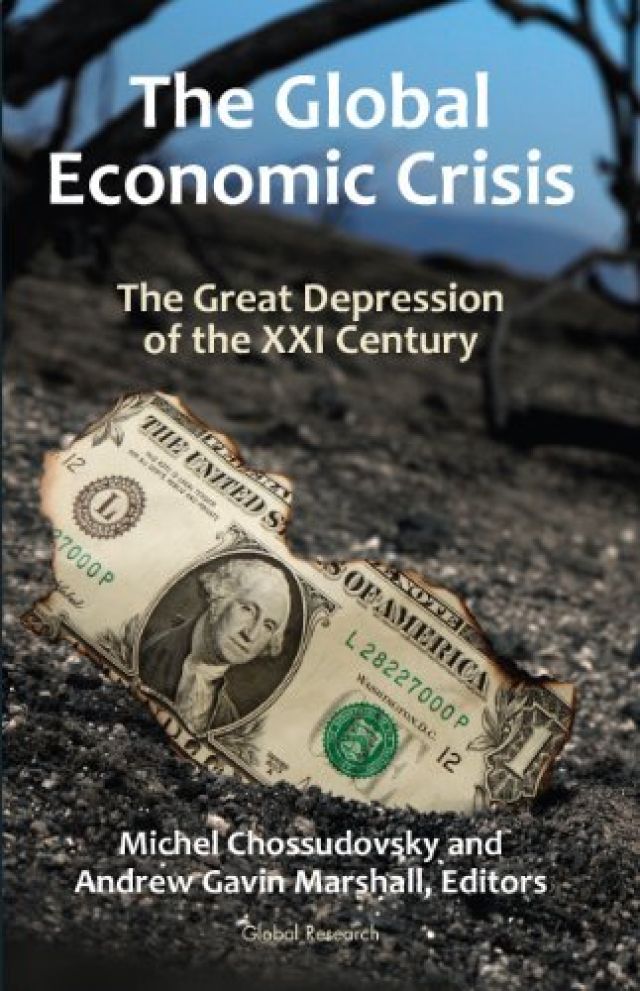
The Global Economic Crisis: The Great Depression of the 21st Century
Edited by Michael Chossudovsky & Andrew Gavin Marshall
Global Research, 2010
The Centre for Research on Globalisation (CRG), based in Montreal, runs a website that publishes in-depth analysis of economic and strategic issues aimed at countering that offered by the mainstream media.
The Global Economic Crisis is a collection of such articles by regular contributors to the CRG website, such as James Petras, Peter Dale Scott and Michel Chossudovsky, which looks at the current economic crisis.
It also looks at the accompanying worldwide process of militarisation — a “war without borders”, the Pentagon’s “long war” — which is intimately related to the neoliberal restructuring of the global economy that has produced the economic crisis.
The contributors to The Global Economic Crisis reinsert class and politics into discussion of the economy.
While mainstream economics is presented as a neutral science, purified of class and political elements — the mythology of the self-regulating market — the contributors reveal the invisible hand of the capitalist class, hidden behind the veil of the market and competition.
They argue that the global financial crisis did not begin with the 2008 meltdown. It was deeply rooted in major changes to the global economy and financial architecture implemented since the 1980s.
This was the outcome of the process of financial deregulation and macroeconomic reform, presided over by the World Bank, the International Monetary Fund and the World Trade Organisation.
The expansion of world capitalism (globalisation) depended on a global cheap labour economy.
The development of industrial colonies in the Third World resulted in the relocation of industries to these countries, leading to job lay-offs and the outright closure of a wide range of productive industries in the developed countries.
In the absence of meaningful state regulation, this relentless process of minimising labour costs led to a dramatic compression of society’s capacity to consume.
People were impoverished not as a result of a scarcity of productive resources but because productive activities are closed down — causing a collapse in aggregate demand.
Mass poverty and a worldwide decline in living standards have been the result of this global cheap labour economy.
The exploitation of the huge labour forces in China, India and elsewhere — and the pillage and transfer of billions from ex-communist Russia and “neo-liberalised” South America — filled the coffers of old financial institutions.
Huge surplus profits spilled over into finance, real estate and insurance, giving capital greater social and political power. This dwarfed the organisation of labour, limiting its bargaining power and multiplying profits.
The state and state policy became their instrument as public enterprises, land, resources and banks were privatised.
This speculative onslaught, a worldwide scramble to appropriate wealth through financial manipulation, has been the driving force behind the crisis.
Pillage, rents and contraband capital produced a vast new source of financial profits and liquidity.
The incapacity of the capitalist system to reinvest capital in productive ways led to large scale growth of speculator capital in many forms.
This inflated prices in real estate, commodities, hedge funds, securities, mergers and acquisitions. Profits were bolstered via inflated real estate based on expanded credit, highly leveraged debt and outright fraudulent “financial instruments”.
Real estate speculation was extended into the working class as wage and salary earners took advantage of easy loans to join the speculation frenzy based on an ideology of irreversible rising home values.
Workers were compensated by cheap consumer imports produced by low-wage labour forces in newly industrial countries and access to easy credit at home. Double incomes also cushioned the effect of (relatively) declining wages.
The over-accumulation was rooted in the most fundamental capitalist relation: the contradiction between private ownership and social production.
Editor Michael Chossudovsky said the September-October 2008 financial meltdown had nothing to do with free market forces.
It was not the consequence of a cyclical downturn of economic activity, but the result of a complex process of financial manipulation, including speculative trade in derivatives.
These speculative operations drove the market up at opportune moments and then drove it down.
Those who have access to privileged information — political, intelligence and military — had the upper hand in the conduct of these highly leveraged speculative transactions. In turn, private and offshore banking enabled the profit to be transferred from one location to the other.

The financial markets triggered the collapse of listed companies through short selling and other speculative operations. They then cashed in through buying the profitable operations of the bankrupted operations.
Having caused the financial meltdown, they have cashed in with windfall gains through the bailout money provided under the Bush and Obama administration bank bailouts. This has furthered their control over the real economy, by buying up and acquiring real economic assets; as once highly profitable companies collapse, the money managers pick up the pieces.
The Bush/Obama bailout measures will contribute to a further destabilisation by transferring large amounts of money at taxpayers’ expense into the hands of private financiers, resulting in a spiralling public debt and an unprecedented centralisation of banking power.
State-owned assets and everything under state jurisdiction is up for private acquisition as the financial establishment calls for the restructuring and privatisation of state assets.
What we are dealing with is a large-scale process of appropriation, unprecedented in history.
It is impossible in a short review to deal with all the issues raised in this thought-provoking book. Besides the section on the financial crisis, there are detailed and informed sections on global poverty, war, national security and world governance, the global monetary system and the shadow banking system.